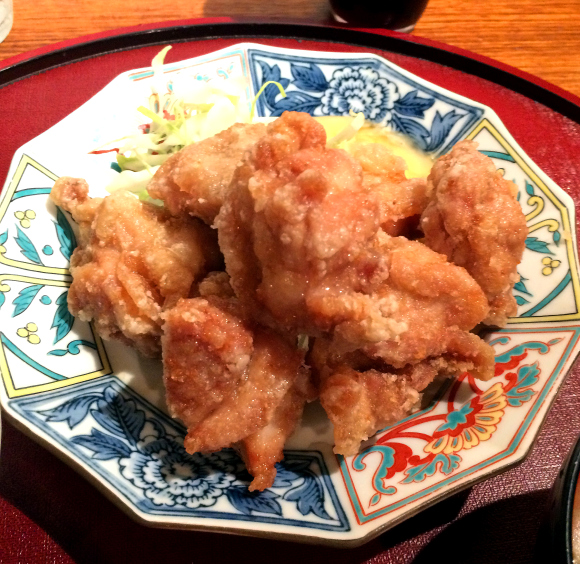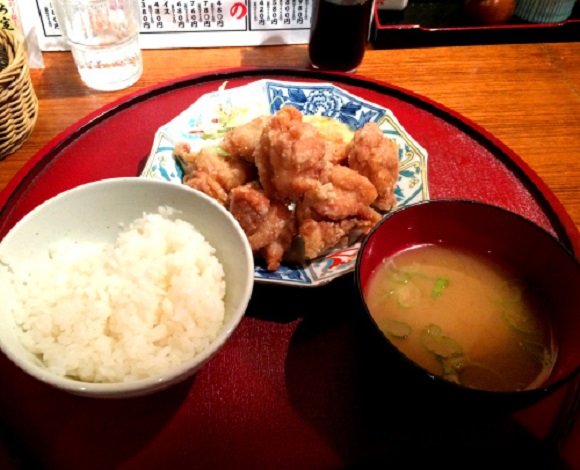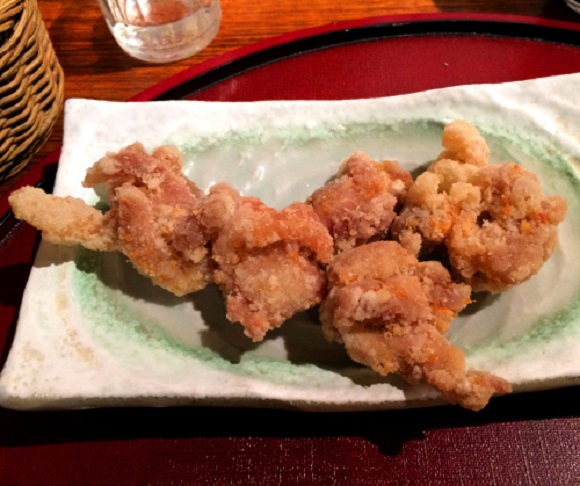
Let it never again be said that America is the only country that has an unhealthy relationship with fried foods.
While you may not find such cynically, blatantly unhealthy fare as fried butter and fried Oreos here in Japan, you will find that many square meals consumed in Japan are going to come with some kind of fried food. A lot of times the default is karaage, a dish that is basically the Japanese analogue to American fried chicken, and an item that Japanophiles the world over desperately, vainly argue is somehow healthier than American fried chicken by virtue of its, uh… Japanese-ness or something?
The truth is, karaage is every bit as unhealthy as fried chicken from anywhere else and the Japanese are just as prone to gorging on it to the point of discomfort. Don’t believe us? Exhibit A: This all-you-can-eat fried chicken restaurant we went to for, uh… “research purposes.”
More specifically, our beloved Mr. Sato went to check out the all-you-can-eat fried chicken cholesterol-fest at Wataribouzu in Tokyo’s Gotanda, because, come on, the rest of us have families here.
The interior decor and menu of Wataribouzu resembles that of any other minor izakaya Japanese pub, Mr. Sato writes, except that for a mere 690 yen (US$5 or so), you can chow down on as many pieces of fried chicken as you could possibly want.
While the restaurant’s menu is varied and pretty expansive, the all-you-can-eat chicken deal comes with just a side of rice and miso soup – but that’s really of little concern when you can order as many pieces of the chicken as you want right up front. Other restaurants in Tokyo that offer all-you-can-eat options often try to approach something vaguely resembling a profit by limiting your orders to single plates at a time, putting an effective cap on how much you can actually order before your time expires, but not so here – if you want your first plate of fried chicken to contain 20 pieces, just ask for 20 pieces.
Around lunchtime, when the all-you-can-eat menu is offered, Mr. Sato says Wataribouzu can get pretty packed, so if you do plan on going, it’s wise, he points out, to order as many pieces as you think you can handle right up front, lest you get stuck waiting up to 15 or 20 minutes for a second batch.
As for taste? Mr. Sato says the karaage is excellent, marinated in the restaurant’s signature soy-based sauce and perfectly fried for a crunchy outside and juicy, soft interior. Also, he, uh… mentioned something about 11-yen beers (for the first round, anyway) through the month of July, as the restaurant celebrates its 11th anniversary, but you couldn’t possibly care about that, right?
If you’re planning on taking advantage, keep in mind that Wataribouzu is open only for dinner on weekends and lunch hours on weekdays are from 11:30 a.m. to 2 p.m. , so show up early if you plan on ordering a bunch of plates, as they’ll probably cut you off at 1:30 p.m.
Restaurant information
Wataribouzu / わったりぼうず
Address: Tokyo-to, Shinagawa-ku, Nishi Gotanda 1-7-1, Ribio Gotanda Pragma G Tower basement level 1
東京都品川区西五反田1-7-1 リビオ五反田プラグマGタワーB1
Open Monday-Thursday 11:30 a.m.-2 p.m., 5 p.m.-2 a.m.; Friday 11:30 a.m.-2 p.m., 5 p.m.-5 a.m.; Saturday 5 p.m.-2 a.m.; Sundays/holidays 5 p.m.-midnight; days preceeding holidays 5 p.m.-5 a.m.
Photos ©RocketNews24
[ Read in Japanese ]






 At under a buck, Tokyo restaurant’s all-you-can-eat fried chicken is a ticket to poultry paradise
At under a buck, Tokyo restaurant’s all-you-can-eat fried chicken is a ticket to poultry paradise Tokyo’s awesome all-you-can-eat deals continue with unlimited fried chicken for under 10 bucks
Tokyo’s awesome all-you-can-eat deals continue with unlimited fried chicken for under 10 bucks Tokyo restaurant’s all-you-can-eat curry, udon is under five bucks, comes with free fried chicken
Tokyo restaurant’s all-you-can-eat curry, udon is under five bucks, comes with free fried chicken Shuko Chiichi restaurant in Tokyo boasts all-you-can-eat deep-fried chicken and other sides
Shuko Chiichi restaurant in Tokyo boasts all-you-can-eat deep-fried chicken and other sides We try the sweets, soups, pastas, and fried chicken of KFC’s all-you-can-eat buffet restaurant
We try the sweets, soups, pastas, and fried chicken of KFC’s all-you-can-eat buffet restaurant Cyberpunk anime meets traditional culture in Ghost in the Shell gold leaf Japanese changing screens
Cyberpunk anime meets traditional culture in Ghost in the Shell gold leaf Japanese changing screens 7-Eleven Japan’s ramen-cooking robot whipped us up a bowl of noodles【Taste test】
7-Eleven Japan’s ramen-cooking robot whipped us up a bowl of noodles【Taste test】 More Than a Capsule Stay: Why Solo Travelers Choose “global cabin Yokohama Chinatown”
More Than a Capsule Stay: Why Solo Travelers Choose “global cabin Yokohama Chinatown” This is possibly the coziest train in all Japan thanks to onboard hot spring footbaths【Pics】
This is possibly the coziest train in all Japan thanks to onboard hot spring footbaths【Pics】 Starbucks Japan ready to get Year of the Horse started with adorable drinkware and plushies【Pics】
Starbucks Japan ready to get Year of the Horse started with adorable drinkware and plushies【Pics】 J-horror classic Ring 2 airing on Japanese TV with Zen monk offering prayers every time someone dies
J-horror classic Ring 2 airing on Japanese TV with Zen monk offering prayers every time someone dies Real Buddhist monk plays Super Mario Bros., recites prayers every time he kills an enemy【Video】
Real Buddhist monk plays Super Mario Bros., recites prayers every time he kills an enemy【Video】 Who shall I be today? The amazing makeup skills of Zawachin
Who shall I be today? The amazing makeup skills of Zawachin Japanese schoolgirls’ hemlines are still up, but socklines are way down
Japanese schoolgirls’ hemlines are still up, but socklines are way down Mister Donut Japan to Change Product Ingredients for First Time in 42 Years
Mister Donut Japan to Change Product Ingredients for First Time in 42 Years Disillusionment at Tsukiji’s tourist-target prices led us to a great ramen restaurant in Tokyo
Disillusionment at Tsukiji’s tourist-target prices led us to a great ramen restaurant in Tokyo Japan may add Japanese language proficiency, lifestyle classes to permanent foreign resident requirements
Japan may add Japanese language proficiency, lifestyle classes to permanent foreign resident requirements Lacquerware supplier to emperor of Japan and Pokémon team up for new tableware
Lacquerware supplier to emperor of Japan and Pokémon team up for new tableware Starbucks Japan releases new zodiac chilled cup drink for 2026
Starbucks Japan releases new zodiac chilled cup drink for 2026 Japan’s otoshidama tradition of giving kids money at New Year’s gets a social welfare upgrade
Japan’s otoshidama tradition of giving kids money at New Year’s gets a social welfare upgrade Hello Kitty Choco Egg figures are an adorable trip through three periods of Japanese pop culture【Pics】
Hello Kitty Choco Egg figures are an adorable trip through three periods of Japanese pop culture【Pics】 7-Eleven Japan starts new temporary luggage storage service in over 300 branches
7-Eleven Japan starts new temporary luggage storage service in over 300 branches Can a dirty butthole make you filthy rich in Japan? We’re starting a New Year’s lottery experiment
Can a dirty butthole make you filthy rich in Japan? We’re starting a New Year’s lottery experiment Japan’s human washing machines will go on sale to general public, demos to be held in Tokyo
Japan’s human washing machines will go on sale to general public, demos to be held in Tokyo Starbucks teams up with 166-year-old Kyoto doll maker for Year of the Horse decorations【Photos】
Starbucks teams up with 166-year-old Kyoto doll maker for Year of the Horse decorations【Photos】 Tokyo considering law requiring more trash cans following litter increase in heavily touristed area
Tokyo considering law requiring more trash cans following litter increase in heavily touristed area Tokyo’s Tsukiji sushi neighborhood asks tour groups to stay away for the rest of the month
Tokyo’s Tsukiji sushi neighborhood asks tour groups to stay away for the rest of the month Nintendo’s Kirby now delivering orders at Kura Sushi restaurants, but not in Japan
Nintendo’s Kirby now delivering orders at Kura Sushi restaurants, but not in Japan Tokyo event lets you travel back in time, for free, to celebrate 100 years since Showa era start
Tokyo event lets you travel back in time, for free, to celebrate 100 years since Showa era start Sanrio theme park in Japan announces plans to expand into a Sanrio resort
Sanrio theme park in Japan announces plans to expand into a Sanrio resort Stamina-destroying “Paralysis Noodles” are Tokyo’s newest over-the-top ramen innovation
Stamina-destroying “Paralysis Noodles” are Tokyo’s newest over-the-top ramen innovation Survey asks foreign tourists what bothered them in Japan, more than half gave same answer
Survey asks foreign tourists what bothered them in Japan, more than half gave same answer Japan’s deadliest food claims more victims, but why do people keep eating it for New Year’s?
Japan’s deadliest food claims more victims, but why do people keep eating it for New Year’s? We deeply regret going into this tunnel on our walk in the mountains of Japan
We deeply regret going into this tunnel on our walk in the mountains of Japan Studio Ghibli releases Kodama forest spirits from Princess Mononoke to light up your home
Studio Ghibli releases Kodama forest spirits from Princess Mononoke to light up your home Major Japanese hotel chain says reservations via overseas booking sites may not be valid
Major Japanese hotel chain says reservations via overseas booking sites may not be valid Put sesame oil in your coffee? Japanese maker says it’s the best way to start your day【Taste test】
Put sesame oil in your coffee? Japanese maker says it’s the best way to start your day【Taste test】 The top 10 annoying foreign tourist behaviors on trains, as chosen by Japanese people【Survey】
The top 10 annoying foreign tourist behaviors on trains, as chosen by Japanese people【Survey】 No more using real katana for tourism activities, Japan’s National Police Agency says
No more using real katana for tourism activities, Japan’s National Police Agency says Starbucks Japan reveals new sakura drinkware collection, inspired by evening cherry blossoms
Starbucks Japan reveals new sakura drinkware collection, inspired by evening cherry blossoms All-you-can-eat fried chicken in one of Tokyo’s most fashionable neighborhoods for under 7 bucks
All-you-can-eat fried chicken in one of Tokyo’s most fashionable neighborhoods for under 7 bucks We visit the new all-you-can-eat KFC buffet restaurant in Tokyo
We visit the new all-you-can-eat KFC buffet restaurant in Tokyo Kentucky Fried Chicken set to open all-you-can eat buffet restaurant in Japan
Kentucky Fried Chicken set to open all-you-can eat buffet restaurant in Japan Kentucky Fried Chicken has all-you-can-drink beer in Tokyo for less than 10 bucks
Kentucky Fried Chicken has all-you-can-drink beer in Tokyo for less than 10 bucks Tokyo ramen restaurant has 50 kinds of all-you-can-drink sake, unlimited gyoza and fried chicken
Tokyo ramen restaurant has 50 kinds of all-you-can-drink sake, unlimited gyoza and fried chicken Japanese restaurant has all-you-can-eat juicy fried chicken for LESS THAN A DOLLAR
Japanese restaurant has all-you-can-eat juicy fried chicken for LESS THAN A DOLLAR Japanese restaurant’s all-you-can-eat fried chicken breakfast is high-score challenge with prize
Japanese restaurant’s all-you-can-eat fried chicken breakfast is high-score challenge with prize Awesome Tokyo ramen restaurant’s all-you-can-drink plans start at less than three bucks
Awesome Tokyo ramen restaurant’s all-you-can-drink plans start at less than three bucks Tokyo restaurant’s all-you-can-eat gyoza and all-you-can-drink beer starts at just 20 bucks
Tokyo restaurant’s all-you-can-eat gyoza and all-you-can-drink beer starts at just 20 bucks We try all-you-can-eat sushi for less than $8.50 at a restaurant in Tokyo’s Chiyoda Ward
We try all-you-can-eat sushi for less than $8.50 at a restaurant in Tokyo’s Chiyoda Ward KFC Japan celebrates Colonel’s birthday with all-you-can-eat fried chicken, free for some kids
KFC Japan celebrates Colonel’s birthday with all-you-can-eat fried chicken, free for some kids There’s a permanent all-you-can-eat, all-you-can-drink KFC restaurant opening in Tokyo
There’s a permanent all-you-can-eat, all-you-can-drink KFC restaurant opening in Tokyo Is the all-you-can-eat KFC buffet in Tokyo really as good as they say it is?
Is the all-you-can-eat KFC buffet in Tokyo really as good as they say it is? KFC offering all-you-can-eat fried chicken in Japan every Wednesday starting in mid-summer!
KFC offering all-you-can-eat fried chicken in Japan every Wednesday starting in mid-summer! The dream of all-you-can-eat Japanese convenience store fried chicken is now a reality
The dream of all-you-can-eat Japanese convenience store fried chicken is now a reality All-you-can-eat KFC returns to 247 locations across Japan this April!
All-you-can-eat KFC returns to 247 locations across Japan this April!
Leave a Reply